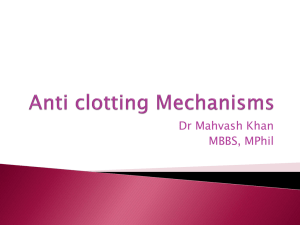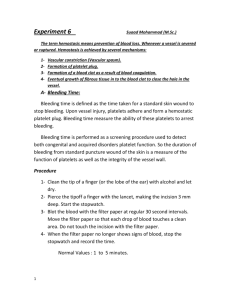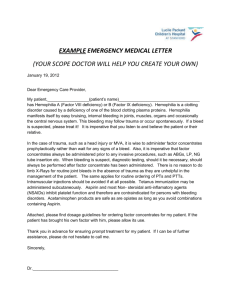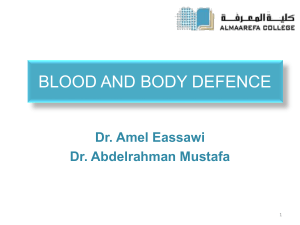Hemostasis -(L5
advertisement
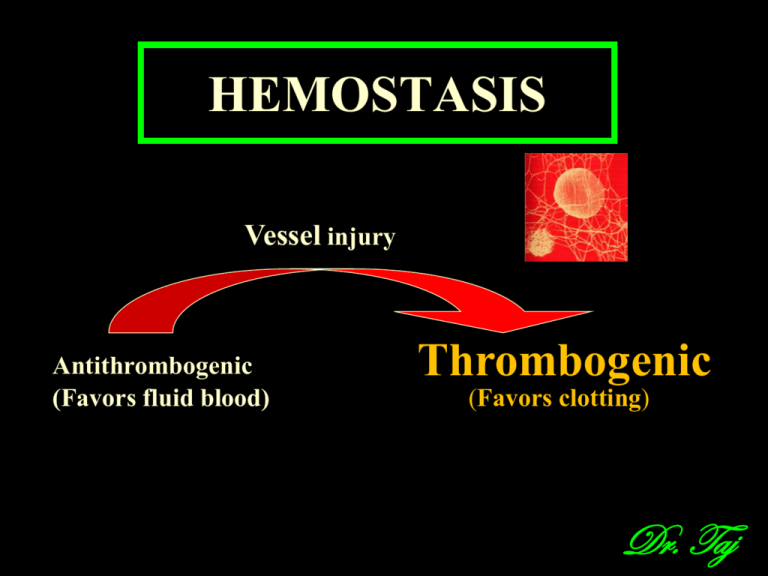
HEMOSTASIS Vessel injury Antithrombogenic (Favors fluid blood) Thrombogenic (Favors clotting) Dr. Taj OBJECTIVES At the end of the lecture you should be able to describe….. What is hemostasis What are the steps of hemostasis The 2 pathways of coagulation The role of platelets in hemostasis Bleeding & clothing disorders HEMOSTASIS From an injured blood vessel is the Prevention of blood loss Or Stoppage of bleeding Or Arrest of bleeding from a broken blood vessel STEPS OF HEMOSTASIS Vascular Spasm Formation Blood Clot of platelet plug Coagulation Retraction VASCULAR SPASM (Vascular Constriction) Factors Nervous reflexes Local myogenic spasm Local humoral factor For smaller vessels Platelets Thrombokanc A2 Importance Censhing injuries Intense spasm No lethal loss of blood FORMATION OF PLATELET PLUG Importance of platelet plug small vascular damage BLOOD COAGULATION Formation Of Clot Blood clotting is the transformation of blood from a liquid into a solid gel form Pathways Intrinsic Extrinsic Initiated by: Activator substances from traumatized vascular wall, plts & blood proteins Begins to develop in 15-20 sec Minor trauma 1-2 min. Severe trauma physical events of Clotting process PLATELETS Formed by fragmentation from megakaryoctyes PLATELETS SHAPE: MINUTE ROUND OR OVAL DISCS SIZE: 1-4 um IN DIAMETER HALF LIFE: 8-12 DAYS COUNT: 150,000 – 300,000/ microlitrer Contractile, adhesive, cell fragments. Store coagulation factors & enzymes Surface Binding sites for fibrinogen Surface Glycoprotein Antigens-HPA1. FUNCTIONAL CHARACTERISTICS: • ACTIN AND MYOSIN MOLECULES • THROMBESTHENIN • ENDOPLASMIC RETICULUM AND GOLGI APPARATUS • MITOCHONDRIA • ENZYME SYSTEMS FOR SYNTHESIS OF PROSTAGLANDINS • FIBRIN STABILIZING FACTOR • GROWTH FACTOR MECHANISM Formation of Prothrombin activator complex Conversion of prothrombin into thrombin Conversion of fibrinogen into fibrin INITIATION OF COAGULATION Formation Of Prothrombin Activator Complex 2 Ways By Extrinsic pathway trauma to vascular wall and surrounding tissues By Intrinsic pathway trauma to the blood Is the rate - limiting factor CONVERISON OF PRTHROMBIN TO THROMBIN By Prothrombin Activator Complex Prothrombin Plasma protein (Alpha2 globulin) Mol. Wt. - 68,700 Plasma conc. - 15 mg/dl Unstable protein Synthesized by liver Vitamin-K is required for synthesis CONVERSION OF FIBRINOGEN TO FIBRIN Formation Of Clot Fibrinogen Mol. Wt. – 340,000 Plasma conc. – 100 – 700 mg/dl Synthesized in liver ACTION OF THROMBIN ON FIBRONOGEN TO FORM FIBRIN BLOOD CLOT A meshwork of fibrin fibres running in all directions and entrapping blood cells, platelets and plasma CLOT RETRACTION When clot contracts, it expresses most of the fluid from the clot within 20-60 min. Serum SERUM CANNOT CLOT ROLE OF PLTS IN CLOT FORMATION VICIOUS CIRCLE OF CLOT FORMATION Clotting Factors EXTRINSIC MECHNANISM FOR INITIATING CLOTTING INTRINSIC MECHNANISM FOR INITIATING CLOTTING ROLE OF THROMBIN IN HEMOSTASIS ROLE OF CALCIUM IONS IN CLOTTING Ca++ No Clotting Blood samples are prevented from clotting by adding: No ions Deionization of Ca++ Oxalate ions ppt the Ca++ Citrate LYSIS OF BLOOD CLOTS PLASMIN Plasminogen / Profibrinolysin T-PA Plasmin or Fibrinolysin Lysis of clot INTRAVASCULAR ANTICOAGULANTS 1. Endothelial Surface Factors 2. Smoothness of Endothelium Glycocalyx Layers Thrombomodulin Protein Antithrombin action of Fibrin and Antithrombin III 85-90 % Thrombin binds with Fibrin 10-15 % Thrombin binds with Antithrombin III INTRAVASCULAR ANTICOAGULANTS 3. Heparin - vely charged conjugated polysaccharide Increase the effectiveness of Antithrombin III Produced by 4. Mast cells Basophil cells Most widely used anticoagulant clinically e.g. in stroke Alpha2 – Macrogobulin Acts as a binding agent for several coagulation factors BLEEDING & CLOTTING DISORDERS A. Liver diseases & Vitamin-K deficiency B. Hemophilia C. Thrombocytopenia BLEEDING DISORDERS A. Liver diseases & Vitamin-K deficiency e.g. Hepatitis, Cirrhosis Decreased formation of clotting factors Icnreased clotting time Vitamin K dependent factors Prothrombin, Factor VII, IX, X HEMOPHILIA HEMOPHILIA Classic 85 Hemophilia % cases Def. Of factor VIII HEMOPHILIA 15 A B % cases Def. Of factor IX THROMBOCYTOPENIA PLT count upto 50,000 ul Less than 10,000 ------ Fatal ETIOLOGY Decreased production Aplastic anemia Leukemia Drugs Infections (HIV, Measles) HEMOPHILIA Genetic disorders Transmitted by female chromosome as recessive trait Occurs exclusively in male Females are carriers Types Hemophilia A Hemophilia B HEMOPHILIA Clinical Features Easy bruising, massive bleeding after trauma or operation, hemorrhages in joints Factor VIII Comp. Hemophilia A Large Comp. Von-Willebrand’s disease Small Rx Injection of factor VIII (Hemophilia A) Injection of factor IX (Hemophilia B) THROMBOCYTOPENIA Increased destruction ITP Drugs Infections Clinical Features Easy brusability Epistaxis Gum bleeding Hemorrhage after minor trauma Petechiae/Ecchumosis THROMBOCYTOPENIA Diagnosis PLT decreased B.T increased Rx Rx of the underlying cause PLT concentrates Fresh whole blood transfusion Splenectomy THANK YOU ANTI COAGULANTS FOR CLINICAL USE Heparin ---------- Subcutaneous or intramuscular Warfarin --------- Oral THROMOEMBOLIC CONDITIONS Thrombus Abnormal clot that develops in a blood vessel Embolus Freely flowing clots Emboli from Lf heart or large arteries ----------- Emboli from Rt heart or venous system --------- Etiology Roughened Endothelia surface Sluggish flow of blood Rx Use of genetically engineered t-PA Use of streptokinase FEMORAL THROMBOSIS & MASSIVE PULMONARY EMBOLISM Prolonged Immobilization Propping the knees with underlying pillows Intravascular clot Grows up and down Clot disengages Venous blood Massive pulmonary embolism DISSEMINATED INTRAVASCULAR COAGULATION Results from Presence of large amounts of traumatized or dying tissue in the body Releases tissue thromboplastin Clots are small and numerous Seen in Septicemic shock BLEEDING DISORDERS A. Vitamin-K Fat soluble vitamin Required by liver for formation 4 clotting factors Sources Diet Sythesized in the intestinal tract by bacteria Deficiency Malabsorption syndromes Biliary obstruction Broad spectrum antibiotics Dietary def (in Neonates) Rx.: Treat the underlying cause Vit K injections

